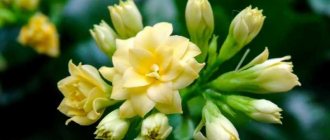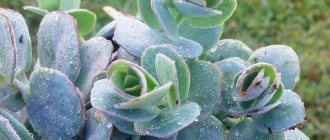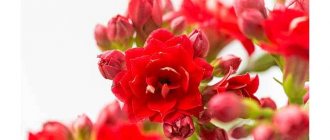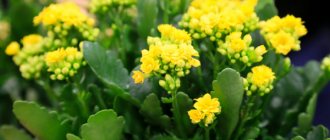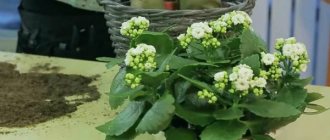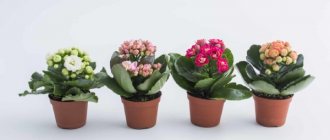Brunfelsia, or Brunfelsia, is an evergreen shrub or small tree that blooms with large lilac, violet, white or yellow flowers, often fragrant. There are 30–40 species in the genus, the homelands of which are the subtropical regions of Central and South America, the Greater and Lesser Antilles.
Why is brunfelsia (brunfelsia) called the Yesterday-Today-Tomorrow flower or the Morning-Day-Night flower
The flowers are initially purple or blue, turning white after a few days. They have a pleasant delicate aroma. Flowers do not bloom at the same time, so on one plant you can see flowers of different shades - from deep purple to white. For this feature, brunfelsia is called “yesterday-today-tomorrow” or “morning-day-night”.
brunfelsia blooming
In indoor culture, the most common is Brunfelsia pauciflora , a slow-growing shrub up to 1–1.5 m high (in nature up to 3 m). The leaves are 8-10 cm long, entire, dark green, matte, leathery. Flowers are up to 5 cm in diameter, collected in 2-10 pieces in few-flowered inflorescences.
Features of the plant
All types of Kalanchoe have common characteristics. Because succulents grow in the hot climates of Africa, Asia and South America, their leaves are adapted to store moisture and resemble thick pads. It is not for nothing that the family to which all Kalanchoe plants belong is called Crassulaceae.
Representatives of different species and varieties differ significantly from each other.
If Kalanchoe in a pot, as a rule, is a herbaceous plant or a small shrub, about 20 cm high, then in nature representatives of this family can grow up to two meters. The Kalanchoe flower can be red, yellow, orange, white, purple, pink, and vary in shape and size.
All are united by common features characteristic of Kalanchoe:
- fibrous, well-developed root system located in the top layer of soil;
- the stems are dense, juicy, completely covered with leaves;
- the fleshy leaves are dark in color;
- four-membered flowers are collected in panicle inflorescences.
Flowers can be erect or drooping, such as those of Kalanchoe mangina.
The flower of this type of Kalanchoe even in the photo looks fascinating. It is not surprising that this ampelous indoor plant is popular and loved among gardeners.
Mattiola
Night violet or matthiola is currently lost among modern fashionable flowers. Many gardeners avoid planting it in their flower beds - its flowers are small, inconspicuous, although they look like a small cloud.
During the daytime, the flowers are almost closed and look withered, which does not decorate the garden. But in the evening the inflorescences come to life: white, purple, yellow inflorescences emit an intoxicating aroma. In the morning the flower looks like “Cinderella” again.
Mattiola blooms all summer, from June to the last days of August. Levkoy also belongs to the genus Matthiola; this species has more beautiful flowers, but is inferior in aroma to annual Matthiola.
Types and varieties of Kalanchoe
Kalanchoe flowers of different varieties differ greatly from each other in shape, size and color. Most decorative varieties of Kalanchoe are bred through selective breeding, which makes it easier to keep in the house and ensures long-term flowering.
Kalanchoe Benta
A subshrub that is cultivated in cold greenhouses. Grows up to a meter tall. Large rounded leaves resemble thick needles and grow up to 40 cm in length. The flowers are white, with a tube at the base of the corolla.
Feathery Kalanchoe (kalanchoe pinnata)
In nature, pinnate grows more than a meter in height, has a thick stem and large leaves. Indoor flowers of Kalanchoe pinnate are much smaller than their wild relatives.
This variety is the most popular, it is familiar to many, it is used for medicinal purposes. On the serrated fleshy leaves, “babies” grow along the edge, with which the plant reproduces.
With proper care, the plant produces a long arrow on which pink flowers resembling bells bloom.
Kalanchoe daigremontianum
The Degremona variety is similar to the pinnate variety, with the only difference being that its leaves are rounded and not elongated.
Kalandiva
How to recognize sorrel
The oxalis flower naturally lives in Central European, South African, South American and Russian deciduous forests. Oxalis is successfully grown in greenhouses and houses. The flower itself is quite miniature, reaching 30 cm in height. The bushes are pubescent with three-leaf or four-leaf leaves, which can fold and droop in the evening, in bright sunlight, in cloudy weather or under mechanical irritation.
The color of the leaves depends on the species and can be purple, green or spotted.
Oxalis flowers bloom in late spring or early summer and delight the eye until late autumn and even until the New Year. They can have different colors: lilac, pinkish, yellow, but most often they are snow-white. Like the leaves, oxalis flowers close under certain factors. After flowering, the plant produces capsule fruits, which, when ripe, are capable of producing red seeds.
In winter, the wood sorrel may go dormant. At the same time, it partially or completely sheds its foliage, which quickly grows back with the arrival of spring.
How to care for Kalanchoe at home
Kalanchoe, which is quite easy to care for at home, has won people’s love and popularity for good reason. The main parameters that make up the care of Kalanchoe are: lighting, temperature and watering.
Since succulents grow in regions with hot climates, they need to maintain a microclimate close to natural. But it would be hard to call these indoor plants picky and capricious.
Caring for oxalis during the dormant period
It should be remembered that wood sorrel can bloom in December, which is why it is called the Christmas flower of happiness and is the best Christmas gift among Americans. However, as soon as the last flowers fade, the plant's growth will stop and the leaves will droop. This is how the wood sorrel notifies its owners that it needs rest.
When a flower goes on vacation, you should not stop caring for it.
During this period, it is recommended to trim the shoots, leaving small stumps (1.5-2 cm) and place the plant in a cool place, but the temperature should not fall below 10 degrees. It is recommended to reduce watering to a minimum and eliminate spraying altogether.
In early spring, when oxalis produces young shoots, the plant should be returned to its original place. If necessary, a transplant must be performed. Oxalis will grow quickly and will begin to produce color within 30-35 days.
Bloom
How often Kalanchoe blooms depends on the conditions under which it is kept. By the whim of nature, Kalanchoe blooms in the autumn-winter period, when the air temperature is relatively low (at night about +70C, during the day - no higher than 150C), and daylight hours are short, 10 hours, no more. The plant blooms profusely on glassed-in loggias, but it is important not to overfreeze it: temperatures of +40C and below trigger irreversible processes in the leaves and stems and the flower dies.
To achieve year-round flowering, you will have to “lower” the air temperature and put the plant in the dark for 14 hours a day.
A freshly purchased flowering bush will not stop flowering if it is placed in partial shade and watered infrequently.
Faded buds need to be cut off, making room for new ones and preserving the aesthetic appearance of the Kalanchoe.
Oxalis - moth wings
The genus Oxalis, or Oxalis, includes about 900 species. Most of them settled in the tropical and subtropical regions of our planet. According to various sources, the homeland of this plant is South America and South Africa; they grow in the highlands of the Andes and in tropical forests, and are rarely found on the plains. These are heat- and shade-loving plants, mainly mesophytes, that is, inhabitants of the low-lying “floors” of the forest. The oxalis flower is grown in open ground; some species are resistant to cold. More on this in the next article. Follow the blog updates!
The botanical name of oxalis is derived from “potassium oxalate,” an inorganic compound of potassium salts and oxalic acid, which the leaves are rich in. Accordingly, this gives them a sour taste, thanks to which in their homeland wild species are used as food, added to salads, snacks and soups. Two more nicknames “rabbit cabbage” and “cuckoo clover” remain a mystery! By the way, oxalis is often compared to meadow clover-shamrock. Many people believe that the official symbol of Ireland is the three-petalled wood sorrel.
collection of florist Oksana
The plant's amazing ability to fold its leaves in bad weather, "before going to bed" and in response to touch makes it an interesting object for observation. For this reason, wood sorrel is often called “butterfly flower” or “moth leaves”. On a thin cutting, the leaves really look like fluttering butterflies! They are not only green; types with purple, burgundy and variegated colors are popular. Together with the leaves, the flowers also close, small, bell-like, they are white, but sometimes pink and even yellow.
The oxalis flower is of great value in folk medicine, although few people know about it. However, with the help of decoctions and tinctures, many diseases are treated: gastritis, heartburn, liver, kidney and gall bladder diseases. Foliage and rhizomes have wound-healing, choleretic, hemostatic, anthelmintic effects, lower blood pressure, and are used both internally and externally to disinfect wounds and treat mucous membranes, as rinses for stomatitis, and compresses for itchy skin. The leaves are rich in vitamin C, so they are used to treat scurvy, and simply for preventive purposes.
Despite the fact that wood sorrel is an unpretentious plant, only four species are grown at home. The simplest, but very cute type is green oxalis, with white or yellow flowers. Oxalis Marginiana has leaves decorated with golden veins. Oxalis triangularis, or purple sorrel, is also popular - a larger species, with bright purple or burgundy leaves that effectively set off delicate pink flowers. Four-leaf oxalis is an excellent gift with wishes of good luck; in European countries it is customary to give it for the New Year, where the flower is associated with the rare four-leaf clover.
O. green
O. marginiana
O. triangularis
O. triangularis
O. four leaf
Flowering at home lasts a long time - from spring until autumn, sometimes even in winter! Oxalis violet, the photo of which is presented above, is often compared to Tradescantia of the same shade. But these two plants are united only by the color of the foliage; they come from different botanical families. Interestingly, sorrel is a tuberous plant, and in some countries it is grown specifically for its tubers, which are also valued in medicine.
Living conditions depending on the season
The conditions of detention directly depend on what the owners want to get from the flower. If the goal is abundant flowering, then the Kalanchoe will have to be hidden in a dark room for one and a half to two months or covered with a dark film (simulating night) for 14 hours a day.
In addition, the air temperature should be close to autumn-winter (+7 at night and +15-16 during the day). Blooming Kalanchoe retains its appearance for several months in a row.
For the winter, the already rare watering is significantly reduced and fertilizing is not applied.
If there is no goal to achieve flowering, then the plant grows as usual, with the only difference being that the western or eastern window can be replaced with a southern one. Shoots that become very elongated due to insufficient winter light are pruned (Kalanchoe can be propagated with them).
Reproduction
There are several ways to propagate Kalanchoe: cuttings, leaves, seeds, “babies”, axillary buds and suckers.
Cuttings
Cuttings are one of the simplest and most popular methods of propagating succulents. Strong, healthy branches about 10 cm long are suitable for cuttings. The apical cuttings, pruned to give the bush a shape, take root well.
The lower leaves are removed from the cut shoot and the cut is cleaned.
- After 10-12 hours, the cuttings are rooted in soil for succulents, deepened by 2-3 cm, watered and left alone.
- The cuttings are placed in water or in a root growth solution (for a day), and then in water, in a warm, shady place. After the roots appear, the cuttings are planted in a pot with soil.
Leaves
Kalanchoe leaves root not only as well, but even better than cuttings. Fallen succulent leaves can be placed in a container with water, and when roots appear, transplanted into the ground. A fresh cut leaf easily takes root in the soil (it needs to be watered and covered with a jar or half a plastic bottle for 4-5 days).
Seeds
The seeds are scattered on the surface of the soil, without deepening them, lightly sprinkled with earth. Water with a thin stream of water, cover the container with a cloth or film and put it in a cool, shady place.
As soon as the sprouts hatch, they are picked and again covered with a transparent film with holes for air circulation. After several true leaves appear, the young shoots can be planted in pots.
Children
Some types of Kalanchoe form small outgrowths on the edges of the leaves, reminiscent of tiny leaves with roots - “babies”. Most often, the “babies” crumble into the ground when you touch the plant, germinate and produce young shoots, which are then replanted.
You can collect the “babies” and sow them in a separate pot for a permanent habitat.
Axillary buds
Axillary buds form in place of fallen leaves. They resemble a small head of cabbage and take root well when transplanted.
Offspring
Kalanchoe forms new shoots growing from the mother - offspring. When they reach 1/3 of the height of the main shoot, they can be transplanted into separate pots.
Other types of Brunfelsia that you can grow at home
Brunfelsia latifolia is a shrub that blooms with larger flowers than Brunfelsia latifolia.
Brunfelsia latifolia compacta variegata is a rare dwarf shrub with stable variegation.
Brunfelsia uniflora is a shrub up to 1–2 m tall, native to the mountains of Brazil and the Antilles. The flowers are usually solitary, about 2.5 cm in diameter, first purple, then bluish, finally white. It blooms quite profusely.
American Brunfelsia, “night beauty” (Brunfelsia americana) is a shrub, up to 1-3 m high, native to the Greater and Lesser Antilles. It blooms with creamy-white large flowers with a pleasant aroma that intensifies in the evening and night hours. Faded flowers become yellowish.
Brunfelsia americana is quite unpretentious and grows well in indoor culture, but it requires a lot of space, so it is better to keep it on an insulated loggia or in a winter garden.
Diseases and pests
Diseases:
- Excessive air humidity and excessive watering can cause the appearance of gray, wet spots that destroy leaf tissue. This is gray rot, which needs to be combated with the help of special preparations, as well as drying the soil and air, placing the pot on the sunny side;
- at high air temperatures, powdery mildew may appear on the leaves - a white fine coating. It will be destroyed by treatment with fungicides, for example, foundationazole.
Pests:
- scale insects are dark tubercles that move along the stems and leaves, feeding on plant juices, causing tissue necrosis. Scale insects are removed mechanically, using a brush and laundry soap;
- In a similar way, you can deal with aphids, colonies of which leave a sticky sticky coating on the leaves, causing them to darken and dry out (drop).
Purple sorrel. Diseases
Like any plant, wood sorrel is also susceptible to attack by various insects - aphids, whiteflies, spider mites, mealybugs, and scale insects love it. You need to make sure that this brethren does not appear on the flower and, if necessary, treat with Aktara or Actellik.
Diseases also do not bypass him. The cause is most often improper care.
- The plant has stopped growing
- it may be hot, move it to a cool room. - Gray rot or fusarium has appeared
- the cause is excessive watering, reduce it and spray the plant with foundationazole. - The leaves have closed in broad daylight
- dry soil or direct sunlight. You need to water the bush and move the pot to another place. - The oxalis flower disappears
- perhaps there is overflow and rotting. Empty the plant from the pot, select undamaged tubers and plant them in new soil. - Spots on the leaves
are most likely burns. Move the oxalis to another location. - A green tint has appeared on the leaves
- lack of light, find a more illuminated window sill for the flowerpot, but not in the sun. - Oxalis has stopped blooming
- either a dormant period has begun or the soil is completely depleted. In the first case, we do nothing, just let the plant rest; in the second case, we need to transplant it into new nutritious soil. But a third option is also possible - too much nutrition, then the leaves become fatty and there will be no color.
Care errors
The main mistakes that novice gardeners make:
- if the leaves lighten or turn red (depending on the variety), the turgor decreases - the plant receives too much light, it needs to be removed to partial shade;
- Kalanchoe does not bloom - the air temperature is too high, the daylight hours are long;
- leaves fall off - there is a heating source nearby, too dry hot air;
- Weeping spots and plaque appear on the leaves - the plant is infected with a disease; treatment with special preparations is necessary.
The main mistakes are too much light, water, heat, Kalanchoe does not like all this. It is better to put the pot in partial shade, reduce daylight hours and keep the temperature no higher than +180C. Water only when the soil is dry, with cool water, without touching the leaves.
Folk signs
It is believed that a blooming Kalanchoe attracts good luck and prosperity to the home. The “babies” along the edges of the leaves resemble coins, and the abundance of flowers is associated with wealth.
In addition, it is believed that Kalanchoe makes the atmosphere in the house healthier. It “establishes” relationships between household members, and attracts couples to single people. The better the pet feels, the greater luck awaits its owner.
Problems growing?
Oxalis is a relatively unpretentious plant that grows well in bright, ventilated and warm rooms and is rarely affected by diseases and pests. However, flower growers often encounter problems that are caused by improper care.
collection of florist Oksana
- If there are spots on the leaves of the sorrel...
Single dry spots are a consequence of sunburn; if the flower was standing in bright sun, the delicate leaves could be damaged. When overmoistened, the leaves begin to darken at the edges, the spots are brown in color and damp to the touch. Dry air can cause leaf tips to turn yellow and dry out. Both cold and stuffiness have a bad effect on the condition of the foliage; foliage may lose its decorative effect due to temperature changes.
Multiple spots or plaque may be the result of a disease or pest attack. Disease diagnosis and pest diagnosis will help you identify the problem.
- If oxalis leaves turn yellow...
Autumn leaf fall often frightens gardeners, but in the cold season the conditions in our apartments are far from natural. In warm weather with a lack of light, the oxalis flower begins to shed its leaves, trying to conserve strength. In winter, it is advisable to choose a cool (16-18 degrees), but well-lit windowsill and water the plant less often, analyzing the condition of the soil. In cool conditions, growth will slow down and in good light the leaves will not stretch to the detriment of their beauty.
- If the sorrel has withered...
Drastic stress can trigger wilting of leaves and flowers: changes in room temperature, excessive heat or cold, change of location, watering errors, or replanting. If the leaves have withered from lack of moisture, after watering they should gain turgor. If wilting was caused by temperature changes, then stabilizing the temperature will gradually bring the plant back to normal.
When overwatering, you should inspect the roots, because wilting of foliage against the background of excess moisture is a dangerous signal! If the leaves do not recover for a long time, it is important to make sure that the roots are in order (not rotten or dry), place the plant under a greenhouse and maintain moderate humidity inside. Immunomodulators - “Zircon” (for root treatment) or “Epin” (for spraying) - can help you survive stress.
Oxalis, which is easy to care for, will probably become your favorite from now on.
Support our site, share the link on social networks. Thank you!
Oxalis or oxalis is a plant from the oxalis family. This name arose due to the fact that the leaves give a sour taste because they are saturated with oxalic acid and vitamins.
Another name familiar to many flower growers is “Butterfly” or “Madama Butterfly”, which appeared due to the characteristic shape of the leaves, similar to the wings of a butterfly.
In European countries, oxalis is called “Clover of Happiness” and they believe that it can bring good luck to the home. But this will happen if the flower changes its owner on the last day of the outgoing year.

